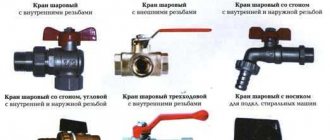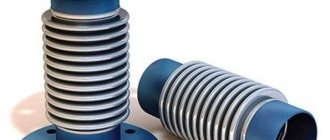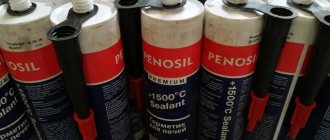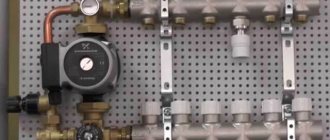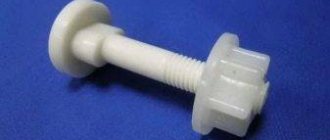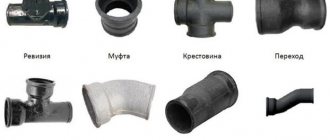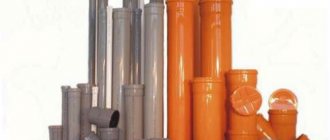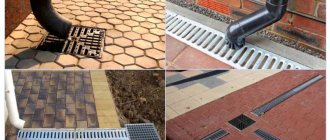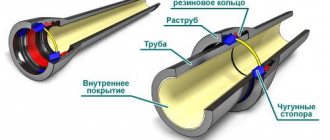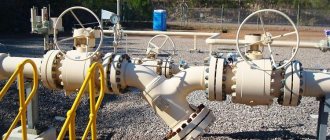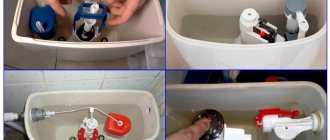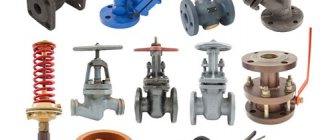Published: 01/2/2012 Category: Tools and accessories, Plumbing work Views: 6287
Water supply system fittings
We are so accustomed to such a benefit of civilization as hot water that we no longer think about where it comes from. In a city apartment, you just need to open the tap for this. But what about in a country house or cottage? After all, there, unlike in the apartment, no one heats the water for us. You'll have to do this yourself. However, in this case there is nothing complicated. You just need to foresee where, how, and most importantly, from what the water will be heated - different heating methods lead to differences in the fittings used.
In this article we will consider only indirect heating devices powered by a boiler or electricity, and the pipeline fittings necessary to supply water from the source to the consumer, i.e. to you and me. The system presented in the diagram below can be divided into several parts: cold water supply to the boiler, hot water from the boiler to the consumer, cold water supply to the consumer. There is no water circulation.
Ball Valves
The faucet owes its name and good characteristics to its design - inside it there is a ball (usually made of brass) with a through channel. When its direction coincides with the axis of the pipe, the throughput is maximum. When the ball is turned (using the rod and handle) 90°, the valve closes.
Ball valve with lever handle
Why is it better to choose this particular tap rather than a gate valve or an ordinary valve? Because it is smaller than a valve, and, unlike various valves, salt deposits do not form on its working surfaces during prolonged operation in aggressive environments (like our water). Ball valves have a high degree of tightness, a long service life (particularly due to the absence of rubber gaskets), and are convenient to use. Ball valves can withstand pressures of about 5 bar, a maximum temperature of +90 degrees Celsius and do not require maintenance.
Ball valve with butterfly handle
During operation, the ball valve should only be in the fully open or fully closed position. Using it as a control device is unacceptable, as this will lead to rapid wear.
The ball valve has several types of handles. The name depends on what the handle looks like, for example a butterfly, a lever, etc. For a cottage, it is better to choose a faucet made of brass (for example, brand J1C59-1). It can also be chrome plated.
Hot water supply diagram indicating the main components
There is one more small, but very important nuance - ball valves must be installed at the inlet (in this case they are called inlet) of the cold water supply in order to de-energize the entire system if necessary. They are located on the pipe in any position, in places convenient for use. The number of cranes depends on the supplied equipment. So, due to the need to periodically replace the cleaning filter, so as not to completely disassemble the system, the tap is placed before and after the filter (see diagram). However, in this case it is possible to use various types of valves and dampers.
The water supply network fittings are
The basic equipment of a water supply network is water pipes. It is through them that water is transported to a given place.
However, the pipeline will be useless without plumbing fixtures. With its help, we can shut off or open a water supply system, protect it from increased pressure, distribute water to consumers and solve a lot of other necessary problems.
Pressure gauge
Most domestic and imported pressure gauges are manufactured in accordance with generally accepted standards, so pressure gauges of different brands can replace each other. The only difference is the price of the device. The instrument scale is limited to 6 bars, the number of divisions depends on the maximum value. But for the average consumer this does not play a special role. When choosing a pressure gauge, you only need to know the thread of the fitting so that there are no problems with installation.
Pressure gauge
If the pressure gauge is mounted on a pipe, you should consider a convenient location of the device, also taking into account the diameter of the housing. Pressure gauges are placed before and after the filter in order to find out from the difference in instrument readings whether it is clogged or not. But it is also possible to omit one pressure gauge if the pressure reducer, which is installed after the filter, already has a pressure gauge.
Strainer and fine filter
Any foreign impurities in the water can damage not only the pipes, but also the fittings installed on them. A clogged tap begins to drip over time, which leads to a loss of up to 150 liters of water per month. Due to leaks, rot occurs, bacteria appear, and corrosion begins. The system may even rupture. And it’s all due to hard water, that is, containing lime. If you think your water is perfect, pay attention to the tiles in the bathroom or shower - limestone deposits on them directly indicate the opposite.
Filter with backwash function
Filters are introduced to purify water. For example, an ordinary mechanical coarse filter will rid the water of grains of sand, small fragments of pipes, scale and other mechanical particles. Some filters have a backwash function, i.e. They self-clean during operation, which extends their service life. Typically the body is made of brass, which contains zinc. During operation, zinc particles may be washed out from the inner surface of the device. To prevent this, it is better to use filters made of dezincification-resistant brass (DZR-brass). This material guarantees a long service life.
Combined water outlet
As a rule, manufacturers make a combined water supply unit that combines a pressure gauge, a filter with backwashing, a pressure reducing valve and a shut-off valve. It should be noted that fine filters are also installed on drinking water, trapping smaller particles. Carbon filters can purify water even from microbes.
Basics of installation of shut-off and control equipment
No pipeline can fully function without shut-off equipment. Due to the fact that there are several of its varieties, the installation of one of them differs significantly from the installation of other devices and should only be carried out by specialists using specialized equipment.
The performance, durability and safety of the pipeline depend on how skillfully the installation work was carried out.
The fittings are connected to the pipeline:
- couplings with internal thread;
- pins on the outer seal;
- nipples;
- flanges;
- welding
Welding is the most reliable method of mutual fastening of pipeline elements and the only one that is suitable for transporting high-pressure media.
Connection using flanges, flat rings or alloy steel discs, bolted to the ends of the parts that need to be fastened, also allows you to ensure the required tightness. Manufacturers of shut-off valves provide a guarantee for their products by conducting tests on the tightness and strength of parts, and their compliance with technical requirements.
Rules for installing shut-off and control valves
There are several important rules that should be followed when installing shut-off and control valves:
1. Mandatory cleaning of the pipeline. After transporting parts, they must be processed manually or by exposure to air, steam or water. When welding, you also need to regularly inspect the pipe for contamination so that the resulting scale does not damage the seal.
2. Check the flanges for irregularities. The smooth surface of the part should not be scratched or have other pronounced defects.
3. Installation of shut-off valves in areas with uneven terrain should be avoided. If the mechanism is not located on a straight section of the pipeline, the stress that occurs at the bends will affect the tightness and cause leaks.
4. Shielding from pressure surges that occur during water hammer, which can damage or disable the entire system, including fittings, is carried out by installing a check valve to ensure a stable flow.
5. Large diameter valves or heavy actuators may require additional support to prevent screws or gaskets from breaking.
6. Shut-off valves can be damaged if too much force is applied to tighten them.
7. Stainless steel fittings must be in the open position during installation.
Pressure reducing valve
This device, in the event of surges in water pressure (up to approximately 30% of the nominal value), reduces it to a predetermined level. Most pressure reducing valves are initially set to 3 bar. To change it, use the adjusting screw. Inside the device there is a membrane that reacts to pressure fluctuations in the system, and a spring that compensates for them. The pressure reducing valve is a rather loud device, but some manufacturers use a special form of the reducer to reduce the noise associated with its operation.
Pressure reducing valve with pressure gauge
The valve body is usually brass, sometimes chrome plated to extend service life. Some are produced assembled with special devices, for example, with a pressure gauge. The operating temperature of the gearbox is up to + 80 degrees Celsius, and the maximum outlet pressure is about 6 bar. This is the pressure that the boiler (water heater) can withstand. The reducer is installed at the cold water inlet into the system. If the water supply is not centralized, but from a well and the pressure does not exceed 5 bar, then it can not be installed.
Relief valve and expansion tank (or hydraulic tank)
Water, heating up in a boiler (water heater), expands and increases in volume by 10-15%. This liquid must be removed somewhere so that the pressure in the heating device does not exceed its maximum value of 6 bar. This is why an expansion tank is needed. It is installed on a pipe supplying cold water. The maximum operating pressure is 10 bar and temperature is 99 degrees Celsius.
Expansion tank
The hydraulic tank has two cavities - for liquid and for air, separated by a rubber membrane. When heated, the pressure increases, excess water raises the membrane in the expansion tank, compressing the air and occupying a larger volume, that is, part of the water goes into the hydraulic tank, which prevents further pressure growth. When the pressure in the network decreases, the tank releases an additional volume of liquid into the system, preventing a further decrease in pressure. The volume of the tank must correspond to 5% of the volume of the water heater (boiler).
Relief valve
As a rule, these are tanks of 5-30 liters. There is a nipple in the upper part of the hydraulic tank, where, if necessary, a pressure gauge is temporarily screwed in to control the pressure or a device for pumping air. A relief valve, or, as it is also called, a relief valve, is installed before the expansion tank. It not only lowers the pressure by pouring out “excess” water, but also simplifies the problem of removing the hydraulic tank, for example, if it is damaged - there is no need to disassemble the entire system. The relief valve is connected to the sewer either directly or through a drain funnel (tap). It is prohibited to place any fittings between the valve and the expansion tank. The vent is sealed and cannot be disassembled or attempted to be adjusted. This should only be done by a specialist.
Characteristics
The key parameter that determines the quality of all elements of shut-off water valves is compliance with the requirements of GOST 19681–94. It specifies the characteristics of products in terms of strength, material design, corrosion protection, etc. The regulations apply to all types of reinforcing elements, with the exception of systems intended for transporting sea or mineral water.
GOST for water fittings determines the possibility of using products on the territory of the Russian Federation. There is also an international standard, which a priori puts forward more stringent requirements for products (in other words, fittings that comply with the international standard, by default, meet GOST standards).
In addition to establishing normal parameters for the fittings themselves, Russian state standards and international standards determine the conditions for their connection to the pipeline. The regulations establish the following requirements:
- according to the pressure level in the lines to which the fittings are supplied;
- according to the diameter of the connected elements.
This list of requirements should be taken into account when choosing along with GOST 19681–94, since it is this that determines the efficiency of the future system at the design stage. That is, it prevents overpayments for possible pipeline alterations.
Safety valve
There is practically no difference between relief valves and safety valves. Both devices are installed in front of the expansion tank and are used to counterpressure water in the pipes. The size of the discharge hole is one step larger than that of the connecting hole. This is necessary to quickly get rid of “excess” water. The spring located inside the valve is made of nickel steel. It is better to choose a brass valve itself. Its maximum operating temperature is 90 degrees Celsius.
Safety valve
The outlet pressure provided during manufacture is from 1.5 to 6 bar. By pressing in the safety cap, the valve is protected from resetting the set value - this cannot be done without compromising the integrity of the cap. If the pressure in the pipe rises sharply and the temperature rises, the valve opens and the water is drained either into a funnel or into the sewer, thereby equalizing the pressure. When there is some kind of disturbance in the system, the safety valve may leak.
Safety relief valve
But there's nothing wrong with that. You should be wary and look for the cause only if it begins to leak. The safety valve is mounted in any position on the pipe in close proximity to the boiler. According to the rules of Rostechnadzor, it is prohibited to install any shut-off valves between the valve and the boiler (water heater).
Return valve for water supply network
This type of fitting prevents the reverse flow of water automatically. In apartments it is well known by the check valve installed when installing the water meter.
There are:
- Check valve (OK) and shutter (slam);
- The foot valve is a check valve mounted in front of the pump;
- Lifting OK;
- Axisymmetric OK;
- Non-return-locking gate;
- Non-return-controlled shutter;
- Non-return shut-off valve;
- Non-return controlled valve;
- Shut-off, high-speed valve;
- Reverse double-leaf valve.
Air vent
Air in systems leads to premature corrosion of pipe materials and fittings, causes noise and creates air pockets that prevent the proper flow of water and reduce heat transfer. It is released using air vents, both manually (Maevsky tap) and automatically. The design of the air vent, which releases only air but not water, is very simple. Inside the brass body, a hollow plastic float moves freely, connected to the spool. If there is no air in the air vent body, the float is in the uppermost position, and the spool closes the hole in the air fitting installed in the brass cover. The cap protects the air channel from dust and dirt, and also allows you to close the air vent in emergency situations and during installation work.
Air vent
To dismantle the air vent without emptying the system, it is recommended to place a shut-off valve in front of it. In its brass body there is a spool, held in the upper position by a spring. When the air vent is installed in the upper thread of the shut-off valve, the valve spool opens. Use an open-end wrench to screw the air vent onto the hexagon of the housing located under the flask. Do not clamp it by the body flask with a pipe lever wrench (KTR). The design dictates vertical installation, otherwise the float will not work. The air vent is installed on the water heater (boiler) - this is, as a rule, a Mayevsky tap. It has a maximum response pressure of 4 to 6 bar and an operating temperature of up to 120 degrees Celsius.
Thermostatic mixer
The temperature of the water supplied from the water heater (boiler) must be above 75 degrees Celsius in order to kill all pathogens (legionella) contained in the water. A thermostatic mixer helps avoid burns in this case. It combines hot and cold water flows - and water at a given temperature is supplied to the consumer.
Thermostatic mixer
Thermostats can be already set to a certain value by the manufacturer or have an adjustment range (on request from 25 to 48 or from 35 to 65 degrees Celsius). The cover protects against accidental reinstallation. The device can be mounted in any position. The body is chrome-plated brass. The maximum water flow depends on the selected model.
Thermometer
It is placed on the hot water supply pipe after the thermostatic mixer. It is used to regulate the temperature of the water that goes to the consumer. But it can be excluded from this scheme if the thermostat already has an automatic setting, or the thermometer is attached to its body. There are several types of these devices, but in our scheme only mechanical ones are used. It is simply irrational to use other thermometers here.
Mechanical, or bimetallic, thermometers operate on the principle of changing the size of a bimetallic spiral (tape, spring). As the temperature increases, the spring unwinds (or curls) depending on the difference in the coefficient of thermal expansion of the metals from which it is made. The inner end of the spring is attached to the body, and an arrow is welded to its second end, which deviates in proportion to the change in temperature. Depending on the type of connection of the stem to the body, thermometers are divided into rear (axial) and radial. The thermometer body is made of chrome or stainless steel. Rod material: brass or stainless steel.
Collectors
Collectors, despite their name, do not collect anything, but distribute water from the main pipeline to consumers. They are made from special food-grade brass that is absolutely safe for humans. The number of outlets is usually from 2 to 12, but there can be more - it depends on the size of the house and its saturation with heating and plumbing equipment. To keep the water pressure in the collector constant, the diameter of the outlet holes is approximately three times smaller than the diameter of the inlet. The longer the manifold and the smaller its cross-section, the more noticeable the pressure loss and difference in flow rate will be.
Collector
Typically, collectors are installed at three quarters with a small number of consumers. If there are many devices for which water is supplied, then it is better to install inch ones. The operating temperature range is from 5 to 100 degrees Celsius, and the operating pressure is about 10 bar.
This is what a collector unit looks like in a good house with a basement, garage, swimming pool, several toilets and bathrooms
These articles may also be of interest to you:
- Replacing the faucet axle box of the mixer
- Installation and repair of a flush tank
- Replacing the siphon and sink drain
- Crane seat repair
Tips for choosing
The choice of fittings depends on several factors, including:
- indicators of working pressure and temperature of the medium in the pipe;
- location on the pipeline;
- frequency of actuation or switching cycles;
- the cross-sectional size of the nominal diameter of the connection pipes and the type of connection;
- material of body parts and presence of anti-corrosion coating;
- permissible level of hydraulic resistance;
- having a throughput capacity of the appropriate volume;
- geometric parameters of the product.
For water supply systems in the residential sector, steel alloy fittings are most often used, especially in cast or forged body designs. The material is able to withstand fairly high pressure and temperature, water hammer and vibration. The products are quite affordable, although not the cheapest.
In systems with more powerful and severe loads, cast iron fittings are installed.
Bronze and brass are used for the manufacture of devices operating in systems with low pressure and temperature.
Plastic products are considered the least reliable, but in some cases their use is allowed.
As with the purchase of any other product, many people choose the most inexpensive products. But you should not focus only on their cost, since a truly high-quality and reliable device will not be too cheap.
It is also advisable to choose models from trusted manufacturers and in specialized stores that can provide guarantees of the quality and reliability of their products. After all, the functioning of the system and its durability depend on the correct choice of shut-off valves for the water supply system.
